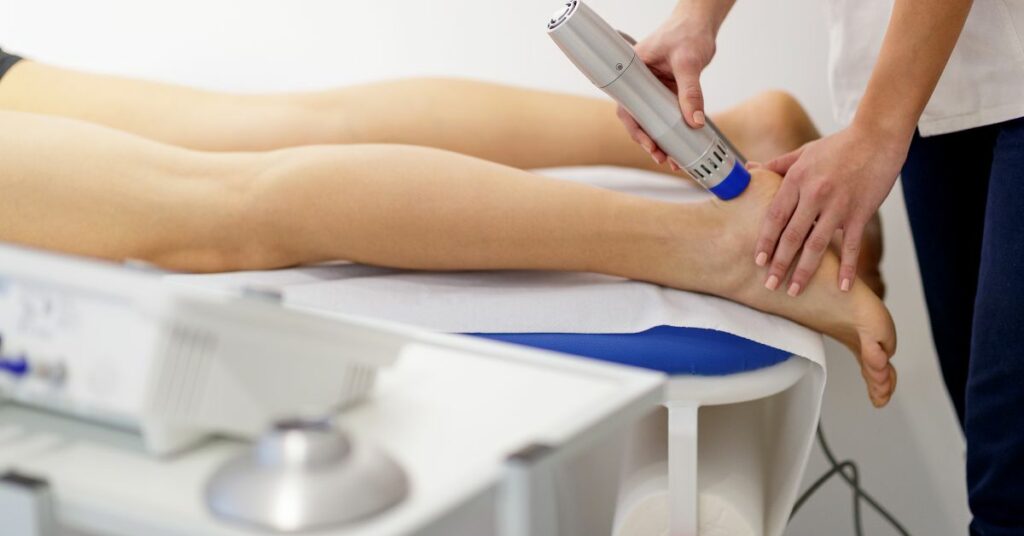If you experience the symptoms of heel spur – such as pain radiating through your feet as you walk – you may be wondering what it is and how to treat it. In this blog post, I provide an overview and discuss the causes and symptoms in detail. In addition, we explore possible solutions for pain relief and prevention.
Whether you suffer from a chronic condition or are curious about preventing heel spur in the future, read on and I’ll explain what you need to do to get back to walking better than ever!
What is heel spur?
Heel spur is a common cause of heel pain and is characterized by calcification or inflammation of the heel tendon plate. Many times this is the result of overuse, poor footwear, being overweight, poor circulation, or standing or walking for long periods of time.
Causes of heel spur
Heel spur is caused by excessive stress on the heel bone or associated tendon. Common causes causing overexertion are:
- Overpronation: This occurs when the foot rolls inward during walking, an abnormal foot position, which puts extra strain on the Achilles tendon and tendon plate ligaments.
- Shortened Achilles tendons: This can be the result of too little stretching and/or overuse, leading to faster injury to the entire foot and ankle.
- Shortened or stiff calf muscles: This can lead to imbalance, causing extra pressure on the Achilles tendon and tendon plate ligaments.
- Overweight/obese: As a person’s weight increases, so does the pressure on the foot and ankles when standing or walking.
- Overuse from sports, running or walking: heel spur can be caused by participation in activities with a high degree of impact on the heel bone.
Symptoms of heel spur
If you experience any of these symptoms, you are probably dealing with heel spur:
Pain when walking
Do you have a sharp pain in your heel every morning on your first steps? This is a sign of heel spur. Your muscles and tendons stiffen after a night of rest, and the combination of that stiffness and the calcification or inflammation can be very painful.
You may also experience pain after sitting for a long time – your muscles are tightened further than normal, so standing up causes an intense jolt of discomfort.
Pain with prolonged standing
Are you on your feet all day long? Or perhaps you have a job that requires you to stand all day? Heel spur can make this kind of prolonged standing or walking really uncomfortable – it can start as a slight stiffness, but over time develop into a real pain.
Pain while driving

Sometimes even the most mundane tasks can be difficult – like driving a car! Holding your foot in an unnatural position on the pedal for an extended period of time can cause intense pain if you suffer from heel spur.
Treatment of heel spur
You want to get rid of these symptoms as soon as possible. Fortunately, there are a few ways to do this.
Rest
Give your feet a rest for a while. Choose in activities that have less contact with the ground, such as swimming or cycling. Always remember to wear quality shoes and do not walk or run barefoot.
Cooling the heel
To reduce swelling, try using an ice bag for a few minutes every day and several times a day if possible. You can also use a plastic bag with some ice cubes in it, applied to the sore spot. This helps reduce swelling and relieve pain.
Heel spur orthotics
These soles provide additional cushioning and relief from tendon plate strain. There are various soles made of different materials. Each with their characteristics. Read all about heel spur orthotics here
Shockwave therapy for heel spur
Shockwave therapy is a treatment that can reduce pain in the foot and aid in healing. The device being used emits energetic shock waves directed at the sore spot in the foot. This can help to stimulate blood flow, promoting the healing process. It can also break down calcifications on the bone.
The treatment may cause some pain, but this is usually only temporary. The number of sessions required may vary depending on the severity of the condition. It is important to consult with your doctor or podiatrist to determine if shockwave therapy is right for you.
Medicine
If necessary, you can also take medications to reduce pain symptoms – paracetamol can help suppress pain symptoms, while anti-inflammatories such as diclofenac or ibuprofen help with inflammation. Be aware of possible side effects before taking these medications.
How can I prevent heel spur?
Worried about heel spur? Fortunately, there are things you can do to prevent the ailment from developing.
Heel spur orthotics
Insoles can help absorb shock and provide extra cushioning for the feet. Good insoles give, slight elevation and extra support in the arch of the foot and to avoid pushing the heel too far back and stressing the tendon plate.
Choose good shoes
Your shoes should provide good arch support and enough cushioning to prevent heel pain caused by overpronation or walking on hard surfaces. Shoes with a very low or thin sole are likely to aggravate the complaint, so look for shoes with good cushioning.
Take a barefoot walk on the beach
A barefoot walk on the beach lets you enjoy nature while helping to strengthen your feet, calves and Achilles tendon – this is especially helpful if you spend a lot of time on your feet during work. Be sure not to walk too much, as this can increase the risk of heel spur.
Replace old shoes on time
Wearing worn-out shoes can cause heel pain because they lose their cushioning over time. Try to replace them before it gets too bad, and remember that alternating between different pairs of shoes helps them last longer – that way you get the best of both worlds!
